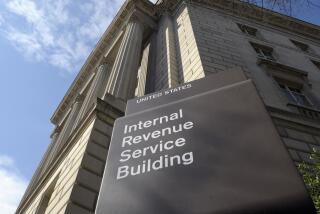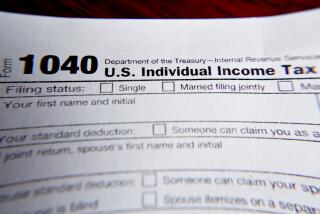. . . to Lessen Tax-Time Frustration
This is part of a continuing series of free-lance columns that help explain how to deal with situations in our lives and/or how to make life more enjoyable.
This is it. No more putting it off. It’s time to tackle that annual ordeal of getting your financial papers together and filing your tax returns.
Too many times, the mere thought of this organizational operation is such a turnoff that procrastination leads to fines or paying extra taxes, because certain papers could not be found in time to file the returns before the deadline.
Early Refunds
Because about 70% of all taxpayers get refunds, the earlier you get your return in, the sooner you will get to use the money that the government has been holding, according to Harvey Goldstein, managing partner of the Southern California accounting firm of Singer, Lewak, Greenbaum & Goldstein.
Goldstein, a member of the state Small Business Development Board and author of the small-business self-help book titled, “122 Minutes a Month to Greater Profits,” outlines the simplest method to use when assembling your tax data.
“The easiest part,” Goldstein says, “is your income record. This is because everybody sends you the forms with the completed information in January. Your employer sends you the W2 form, your savings account and dividends people (if there are any) send you the 1099s, so, unless you are in business for yourself, the income records are provided for you.”
Gathering Information
The really difficult part is gathering information for you or your accountant to itemize deductions, Goldstein says. Many people--even some with very substantial refunds--wait until the last minute or get extensions, just because they simply don’t want to face the task of gathering the necessary data.
Goldstein suggests that you go through all your canceled checks for the year and place them in tax-deductible categories. Expenses that are among your primary deductions may be interest, state taxes, contributions and medical (that are in excess of 5% of adjusted gross income). If you aren’t certain that an expenditure qualifies as a deduction, place the check in a separate stack and ask your tax preparer or the IRS.
Most banks and mortgage companies send a statement at the end of the year stating the total amount of interest you paid. Department stores and credit-card companies generally show on your monthly bill the amount of interest you paid during the previous year.
The amount of state taxes paid during the previous year can be found on last year’s tax return or your current year’s W2 form, so your accountant can easily pick up that figure. And proof of your property-tax payments will either be among your canceled checks or listed on your mortgage statement.
Other Deductibles
What are some of the other things you might look for? The annual assessment from the Department of Motor Vehicles when you renew your auto license; included in that amount is $23 for the actual license fee, which is not deductible, but the amount above $23 is deductible as personal property tax. Among other deductibles are unreimbursed expenses for books, periodicals and educational materials used in your job or business; accounting fees for tax advice and preparation, and lawyer fees that pertain to tax matters.
If you are in business for yourself, items that are “ordinary and necessary” to the operation of the business are deductible. That would include such expenses for office supplies, postage, rent and utilities, labor costs, business-related travel and entertainment and telephone and advertising costs. And, if you operate your business from your home, ask your tax preparer how much you can deduct for the space set aside for your business activities.
When buying equipment for your business, you may want to consult your tax preparer regarding a method for establishing depreciation.
“Ordinary and necessary” are key words in determining business deductions. Goldstein uses as an example an outside salesman who needs a car for his business. It may be a necessary expense, but, if the car he chooses is a Rolls-Royce, one would have to ask: Is it ordinary?
In addition to your day-by-day income-and-expenditure records, there may be some other important documents that you will need.
For example, if you bought a home or any kind of property, save the escrow statements, because deductible items may be listed there. And, if you bought a car, the purchase statement will show that substantial sales taxes were paid.
Keep in mind that deductions may not always be cash-related. When you donate goods--such as clothing or furniture--to charities, you should get an itemized receipt from the charity showing an estimate of the fair-market value of the items you donated, so you can take a tax deduction on that basis. If the value of the donation is in excess of $5,000, you must attach an independent appraisal of the property to your tax return and notify the charity of the amount on the appraisal. If, within two years, the charity sells your donated property, it must notify the IRS of the amount received for it. Should there be a discrepancy, you could be in for a subsequent adjustment on your tax return. Goldstein suggests that you get a tax counsel if you are making large contributions to charity.
Those people who have small, perhaps home-based businesses should be keeping a separate set of books for the business. It is wise to set up a separate checking account with all income from the business going into that account and all business-related expenses being paid out of it. At the end of the year, simply add up the deposits, which represent income for the year. On the expense side, the checks written from that account, totaled and categorized, represent your tax deductions as long as they are business-related, and, once again, “ordinary and necessary.” The difference between the income and the expenses is profit or loss.
As for cash expenses, the simplest thing to do is to set up an envelope for miscellaneous cash expenses and put those receipts into that envelope throughout the year. At the time of purchase, mark on the receipt what the expenditure was for--if you wait until later, you may forget.
“I always recommend that people use a credit card for tax deductible expenditures, so that you have a permanent record of that amount,” Goldstein says. To avoid having to spend a lot of time sorting out the listed expenditures on those credit card statements into personal and business use, it is simpler if people select one credit card to use for business expenses only and use all of their other cards for personal expenses. Generally speaking, deductible expenses charged to a credit card are deductible the year in which the expense was incurred, not in the year or years following when the payments are made. If you have a question about this, consult your tax adviser.
“Finally,” Goldstein concludes, “remember that the burden of proof is on the taxpayers for everything that is listed on their returns. Therefore, if you have any doubts about your tax information, you should get help from a professional.”
With the 1985 tax return filed, it may be a good time to set up a system for next year that will help you avoid the last-minute rush for tax information. One easy way is to label a set of envelopes “Charity,” “Medical,” “Taxes” and so forth. When your bank statement arrives each month, simply pull the applicable checks and put them in the appropriate envelope. Also, file receipts in these envelopes.
More to Read
Inside the business of entertainment
The Wide Shot brings you news, analysis and insights on everything from streaming wars to production — and what it all means for the future.
You may occasionally receive promotional content from the Los Angeles Times.










